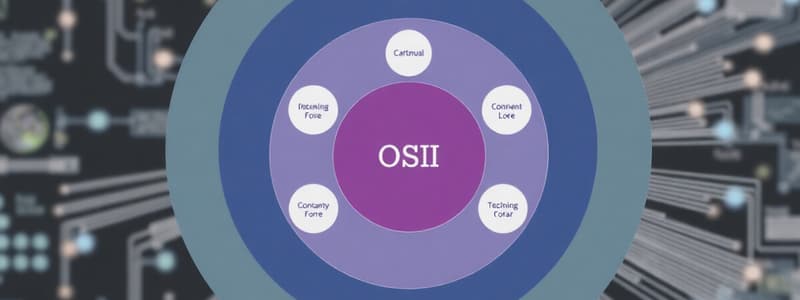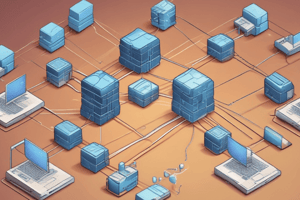Podcast
Questions and Answers
What role does ARP play in reaching a Web server?
What role does ARP play in reaching a Web server?
- It determines the physical MAC address of the default gateway. (correct)
- It verifies the user's credentials.
- It retrieves the website content from the server.
- It establishes a connection with the Web server.
Which layer of the OSI model handles the conversion of the message to be sent to the default gateway?
Which layer of the OSI model handles the conversion of the message to be sent to the default gateway?
- Transport Layer
- Network Layer
- Application Layer
- Data Link Layer (correct)
What is the purpose of inserting the Web request inside a network request?
What is the purpose of inserting the Web request inside a network request?
- To compress the data for quicker transmission.
- To encapsulate the request for delivery to the default gateway. (correct)
- To ensure the data is formatted correctly for the Internet.
- To initiate a secure connection with the Web server.
At which layer does the physical transmission of the Web page request occur?
At which layer does the physical transmission of the Web page request occur?
What does the computer pass to the NETWORK layer after using ARP?
What does the computer pass to the NETWORK layer after using ARP?
What is the main function of the Presentation layer?
What is the main function of the Presentation layer?
Which layer is responsible for ensuring data is broken into manageable chunks?
Which layer is responsible for ensuring data is broken into manageable chunks?
What does HTML stand for, as used in web pages?
What does HTML stand for, as used in web pages?
What type of connection does a web browser establish to request a web page?
What type of connection does a web browser establish to request a web page?
Which protocol is used at the Network layer for addressing computers on the Internet?
Which protocol is used at the Network layer for addressing computers on the Internet?
What happens after a web browser receives a web page from a web server?
What happens after a web browser receives a web page from a web server?
Which of the following is NOT a function of the Presentation layer?
Which of the following is NOT a function of the Presentation layer?
What does a web server do after sending back a web page?
What does a web server do after sending back a web page?
What is the primary function of the Data Link layer?
What is the primary function of the Data Link layer?
Which sublayer is part of the Data Link layer?
Which sublayer is part of the Data Link layer?
What does the Network layer primarily manage?
What does the Network layer primarily manage?
Which protocol is commonly associated with the Transport layer?
Which protocol is commonly associated with the Transport layer?
What does the Session layer primarily regulate?
What does the Session layer primarily regulate?
What role does the Address Resolution Protocol (ARP) serve?
What role does the Address Resolution Protocol (ARP) serve?
Which layer adds the concept of logical addressing?
Which layer adds the concept of logical addressing?
Which of the following best describes the Media Access Control sublayer?
Which of the following best describes the Media Access Control sublayer?
What is the primary function of the Presentation layer in the OSI model?
What is the primary function of the Presentation layer in the OSI model?
Which layer provides services directly to end-user applications?
Which layer provides services directly to end-user applications?
When using a Web browser, which layer mainly handles the display of content to the user?
When using a Web browser, which layer mainly handles the display of content to the user?
What is true about the application layer protocols like HTTP?
What is true about the application layer protocols like HTTP?
Which of the following is NOT a function of the Presentation layer?
Which of the following is NOT a function of the Presentation layer?
What role does a Web browser play in the context of the OSI model?
What role does a Web browser play in the context of the OSI model?
What is the main activity at the Application layer when a user requests a web page?
What is the main activity at the Application layer when a user requests a web page?
What is one major benefit of learning the OSI model?
What is one major benefit of learning the OSI model?
Which of the following best describes the interaction between the Presentation layer and the Application layer?
Which of the following best describes the interaction between the Presentation layer and the Application layer?
Which layer of the OSI model is primarily concerned with the transmission of digital data bits?
Which layer of the OSI model is primarily concerned with the transmission of digital data bits?
How many layers are there in the OSI model?
How many layers are there in the OSI model?
Which of the following is an example of a technology that operates at the Physical layer?
Which of the following is an example of a technology that operates at the Physical layer?
What does the OSI model help clarify regarding Internet Protocol?
What does the OSI model help clarify regarding Internet Protocol?
In what context is the OSI model primarily used today?
In what context is the OSI model primarily used today?
Which of the following describes the role of the lower layers of the OSI model?
Which of the following describes the role of the lower layers of the OSI model?
What does the OSI model divide in computer networking?
What does the OSI model divide in computer networking?
Flashcards
OSI Model
OSI Model
A networking framework that divides computer network architecture into 7 layers for implementing network protocols.
OSI Model's Purpose
OSI Model's Purpose
The OSI model helps to understand how different network functions relate to each other and how protocols work.
Physical Layer (OSI)
Physical Layer (OSI)
The lowest layer of the OSI model, responsible for transmitting data bits over physical media.
Network Layers
Network Layers
Signup and view all the flashcards
Layer 1
Layer 1
Signup and view all the flashcards
Lower Layers vs Higher Layers
Lower Layers vs Higher Layers
Signup and view all the flashcards
7 Layers
7 Layers
Signup and view all the flashcards
Teaching Tool
Teaching Tool
Signup and view all the flashcards
Physical Layer
Physical Layer
Signup and view all the flashcards
Data Link Layer
Data Link Layer
Signup and view all the flashcards
Network Layer
Network Layer
Signup and view all the flashcards
Transport Layer
Transport Layer
Signup and view all the flashcards
TCP
TCP
Signup and view all the flashcards
Session Layer
Session Layer
Signup and view all the flashcards
MAC Address
MAC Address
Signup and view all the flashcards
IP Address
IP Address
Signup and view all the flashcards
Presentation Layer Function
Presentation Layer Function
Signup and view all the flashcards
Application Layer Function
Application Layer Function
Signup and view all the flashcards
Application Layer Example
Application Layer Example
Signup and view all the flashcards
Web Browser Role
Web Browser Role
Signup and view all the flashcards
OSI Model Layer 6
OSI Model Layer 6
Signup and view all the flashcards
OSI Model Layer 7
OSI Model Layer 7
Signup and view all the flashcards
Web page Display
Web page Display
Signup and view all the flashcards
Network Service Protocol
Network Service Protocol
Signup and view all the flashcards
Presentation Layer
Presentation Layer
Signup and view all the flashcards
Web Browser Role (Presentation)
Web Browser Role (Presentation)
Signup and view all the flashcards
Session Layer
Session Layer
Signup and view all the flashcards
HTTP Request
HTTP Request
Signup and view all the flashcards
TCP Connection
TCP Connection
Signup and view all the flashcards
Transport Layer (TCP)
Transport Layer (TCP)
Signup and view all the flashcards
Internet Protocol (IP) Role
Internet Protocol (IP) Role
Signup and view all the flashcards
Network Layer
Network Layer
Signup and view all the flashcards
IP Protocol
IP Protocol
Signup and view all the flashcards
ARP (Address Resolution Protocol)
ARP (Address Resolution Protocol)
Signup and view all the flashcards
Default Gateway
Default Gateway
Signup and view all the flashcards
Web Page Request
Web Page Request
Signup and view all the flashcards
MAC Address
MAC Address
Signup and view all the flashcards
Study Notes
Why Should We Learn the OSI Model?
- Learning the OSI model helps understand functions, web browser operation, internet protocol, ARP, and MAC addresses.
- Learning the OSI model simplifies troubleshooting computer problems and communication with technical personnel.
OSI Model
- The OSI model is a networking framework for implementing protocols in layers.
- It's a valuable teaching tool, logically dividing computer network architecture into 7 layers.
- Lower layers handle electrical signals, binary data, and network routing.
- Higher layers manage network requests, responses, data representation, and user-facing protocols.
- Many popular network technologies today mirror the layered structure of the OSI model.
Physical Layer
- Layer 1 is responsible for the ultimate transmission of digital data bits.
- It transmits data between devices using physical media (cables, radio frequencies, etc.).
- Typical devices at this layer include hubs, repeaters, cables, and connectors.
Data Link Layer
- This layer handles physical addressing (MAC addresses) and checks for transmission errors.
- It groups bits into frames and manages device access to the physical medium.
- It comprises two sub-layers: Media Access Control (MAC) and Logical Link Control (LLC).
Network Layer
- Layer 3 handles routing of data packets.
- It uses logical addresses (e.g., IP addresses) and translates them to physical addresses (e.g., MAC addresses).
- It's responsible for moving packets between source and destination.
Transport Layer
- Layer 4 delivers data across network connections using protocols like TCP.
- TCP manages error recovery, flow control, and retransmission of data.
Session Layer
- Layer 5 manages the connection establishment and termination between applications.
- It supports multiple connections dynamically over individual networks.
Presentation Layer
- Layer 6 simplifies message data by converting formats, handling encryption/decryption.
- Deals with converting data so applications can understand it.
Application Layer
- Layer 7 provides network services to end-user applications (e.g., web browsers).
- Protocols like HTTP operate at this layer, managing application-level interactions.
Studying That Suits You
Use AI to generate personalized quizzes and flashcards to suit your learning preferences.




